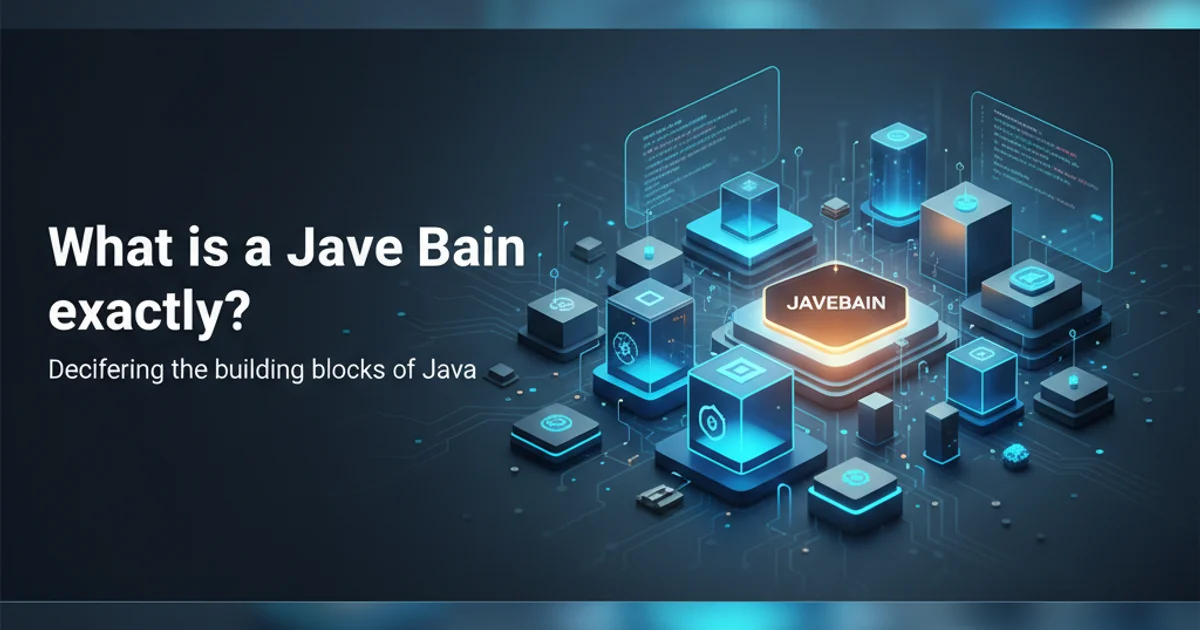What is a JavaBean exactly?
Categories:
Understanding JavaBeans: The Foundation of Reusable Java Components

Explore what JavaBeans are, their core conventions, and how they facilitate component-based development and integration in Java applications.
In the world of Java development, you've likely encountered the term "JavaBean." But what exactly is a JavaBean? Far from being a complex framework, a JavaBean is simply a plain old Java object (POJO) that adheres to a specific set of naming and design conventions. These conventions enable tools and frameworks to easily inspect, manipulate, and reuse components, making JavaBeans a cornerstone of component-based software development in Java.
The Core Conventions of a JavaBean
The power of JavaBeans lies in their simplicity and adherence to a well-defined set of conventions. These conventions allow development tools, such as Integrated Development Environments (IDEs) and application servers, to automatically understand and interact with JavaBean components without needing explicit configuration. This 'introspection' capability is crucial for frameworks like Spring and for visual builders.
classDiagram
class JavaBean {
- String name
- int age
+ JavaBean()
+ String getName()
+ void setName(String name)
+ int getAge()
+ void setAge(int age)
+ void addPropertyChangeListener(listener)
+ void removePropertyChangeListener(listener)
}
JavaBean ..|> SerializableUML Class Diagram illustrating JavaBean conventions
Here are the fundamental conventions that define a JavaBean:
1. Default No-Argument Constructor
A JavaBean must have a public no-argument constructor. This allows tools and frameworks to instantiate the bean programmatically without needing to know specific constructor parameters.
2. Properties via Getters and Setters
Properties of a JavaBean are exposed through public get and set methods. For a property named foo of type FooType, there should be a public FooType getFoo() method and a public void setFoo(FooType foo) method. For boolean properties, isFoo() can be used instead of getFoo().
3. Serializable
JavaBeans should implement the java.io.Serializable interface. This allows the bean's state to be saved (persisted) and restored, which is essential for features like drag-and-drop GUI builders, session management in web applications, and inter-process communication.
4. Event Handling (Optional but Common)
JavaBeans can support event handling by providing methods for registering and unregistering listeners. Common patterns include addPropertyChangeListener() and removePropertyChangeListener() for notifying interested parties when a property's value changes.
Why Use JavaBeans? Benefits and Use Cases
JavaBeans offer several significant advantages that have made them a foundational concept in Java development, particularly in areas requiring component reusability and tool integration.
Key benefits include:
- Tool Support and Introspection: IDEs and visual builders can automatically discover and manipulate JavaBean properties and methods, simplifying development.
- Reusability: JavaBeans are designed to be self-contained, reusable software components that can be easily plugged into different applications.
- Serialization: The ability to persist and restore state is crucial for many application types, from desktop GUI components to web session objects.
- Dependency Injection (DI): Modern DI frameworks like Spring heavily leverage JavaBean conventions. They use getters and setters to inject dependencies and configure components, even if they don't explicitly call them 'JavaBeans' anymore.
- Inversion of Control (IoC): By allowing frameworks to manage the lifecycle and configuration of components, JavaBeans facilitate the IoC principle, where the framework calls into your code rather than your code calling into the framework.
Example: A Simple JavaBean
Let's look at a practical example of a simple JavaBean representing a User.
import java.io.Serializable;
public class User implements Serializable {
private String username;
private String email;
private int age;
// 1. Public no-argument constructor
public User() {
}
// Constructor for convenience (not strictly required by JavaBean spec)
public User(String username, String email, int age) {
this.username = username;
this.email = email;
this.age = age;
}
// 2. Getter for username property
public String getUsername() {
return username;
}
// 2. Setter for username property
public void setUsername(String username) {
this.username = username;
}
// 2. Getter for email property
public String getEmail() {
return email;
}
// 2. Setter for email property
public void setEmail(String email) {
this.email = email;
}
// 2. Getter for age property
public int getAge() {
return age;
}
// 2. Setter for age property
public void setAge(int age) {
this.age = age;
}
@Override
public String toString() {
return "User{" +
"username='" + username + '\'' +
", email='" + email + '\'' +
", age=" + age +
'}';
}
}
In this User class:
- It has a public no-argument constructor.
- It provides public
getandsetmethods forusername,email, andageproperties. - It implements
Serializable.
This simple adherence to conventions makes User a JavaBean, allowing it to be easily managed by frameworks, serialized, and introspected by tools.